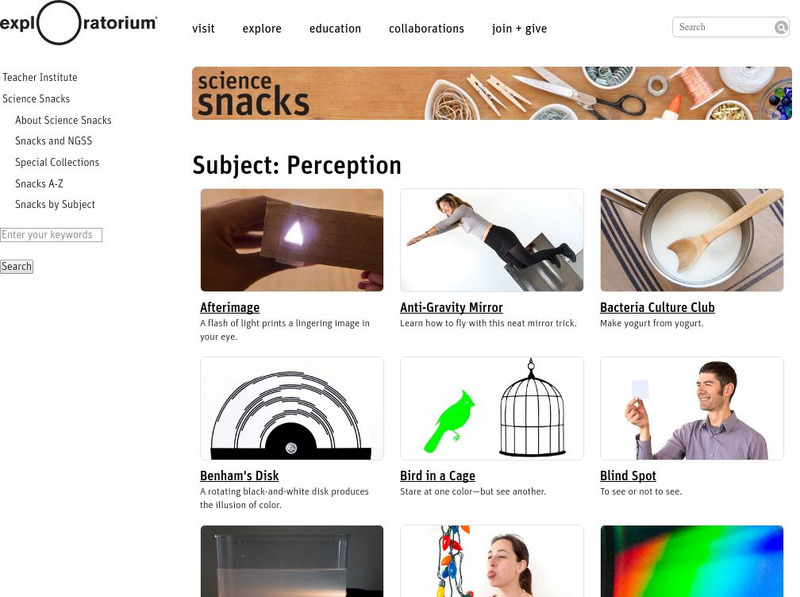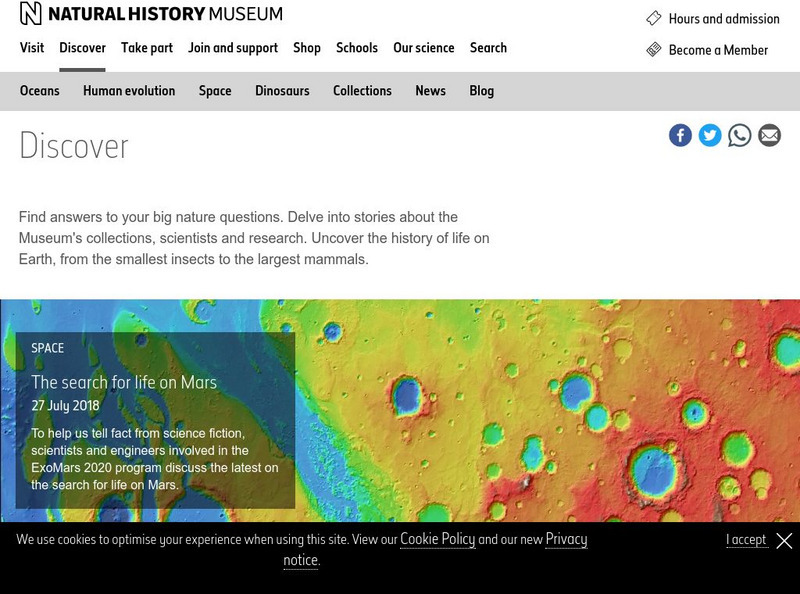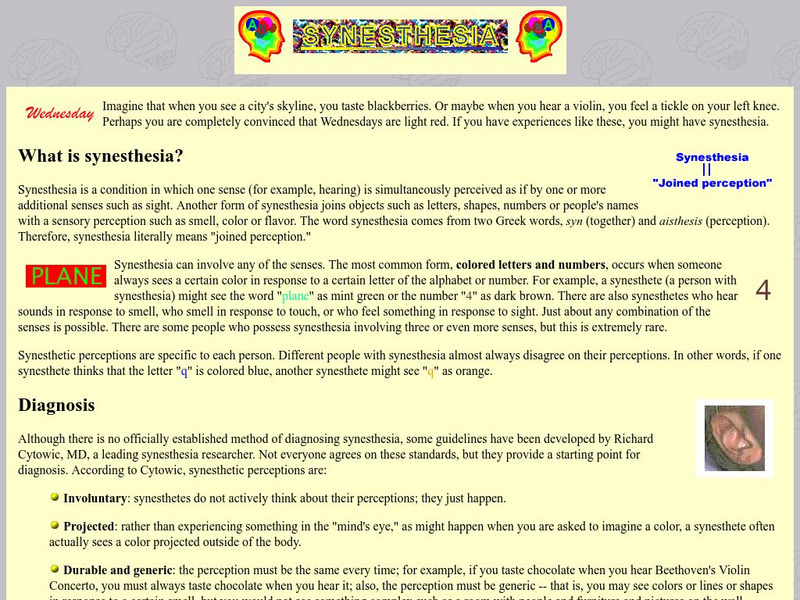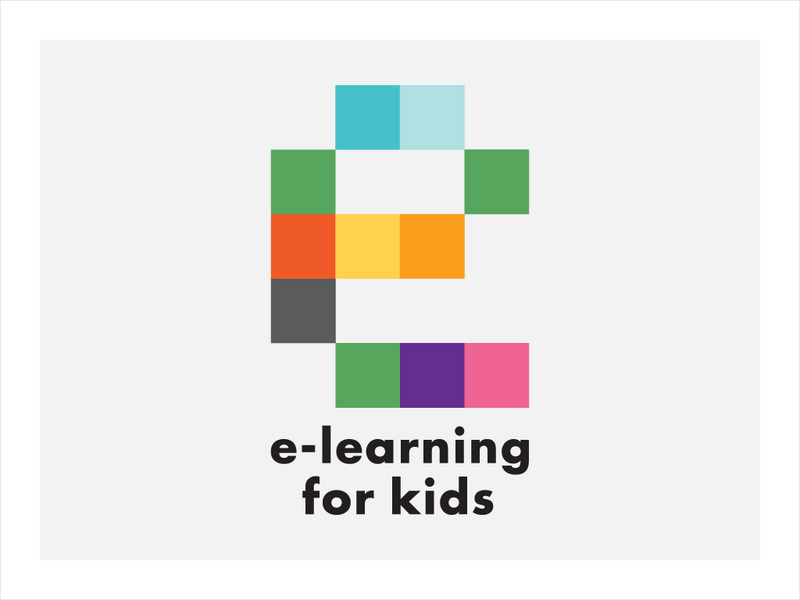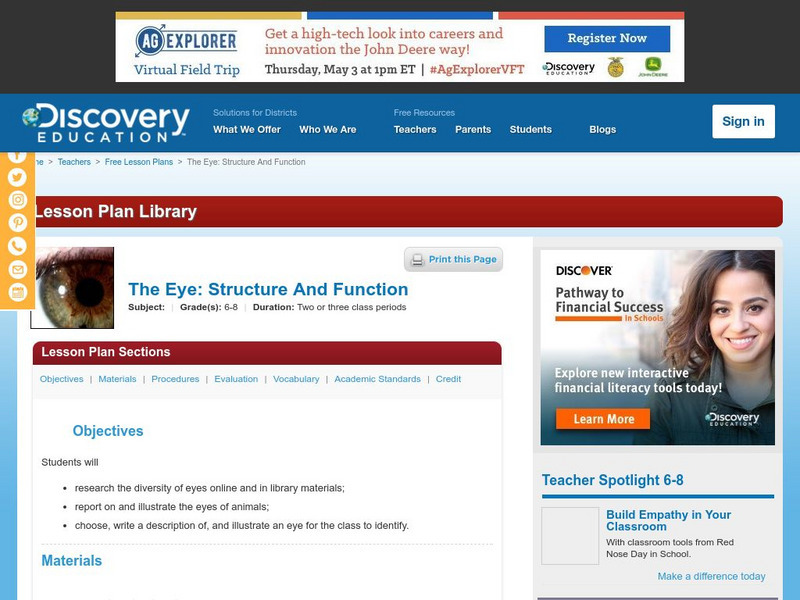Hi, what do you want to do?
PBS
Pbs: Nature: Raptor Vision Game
Gain 20/7 vision by becoming a raptor in this game! Help the Peregrine falcon find its prey in a river scene and see the difference between your vision and its vision!
Aetna Intelihealth
Aetna: Inteli Health: Vision Glossary
Definitions of many technical and anatomical terms related to vision and the eye.
Georgia Department of Education
Ga Virtual Learning: Anatomy and Physiology: Senses
Through informational text with printable notes, animations, video clips, and practice problems students discover the function of the sensory structures in the human body.
Exploratorium
Exploratorium: Science Snacks: Perception
Try one of these 33 perception activities in your classroom.
TED Talks
Ted: Ted Ed: How We See Color
There are three types of color receptors in your eye: red, green and blue. But how do we see the amazing kaleidoscope of other colors that make up our world? The following learning module explains how humans can see everything from...
American Museum of Natural History
American Museum of Natural History: Optical Illusions and How They Work
What you see and what you think you see are different things. Find out what your brain doing behind-the-scenes!
abcteach
Abcteach: Senses Flashcards
[Free Registration/Login Required] Colorful flashcards of the 5 senses with your choice of Arial or D'Nealian lettering.
Library of Congress
Loc: Poetry 180: Blind
The poem shares the sad experience of seeing a loved one lose the sense of sight.
PBS
Pbs: Nature: Raptor Force
Online companion of a Nature documentary about birds of prey, their sense of sight, and their powers of locomotion. Includes a game, Raptor Vision, that lets players see the world through the eyes of a raptor.
Other
Media Visions: Meet Thomas Paine, a Visionary Revolutionist
This biographical article discusses Thomas Paine (1737-1809), English writer and social activist, who is best known for his popular essay, Common Sense, the pivotal call for American independence and democracy.
Ducksters
Ducksters: Biology for Kids: Sight and the Eye
Kids learn about the science of Sight and the Eye. The sense of vision and how it works.
Science Education Resource Center at Carleton College
Serc: Backyard Science the Five Senses
Kindergarten students will use their existing outdoor expertise to help them focus on the scientific study of their five senses in stations.
The Franklin Institute
Franklin Institute and Science Museum: Seeing
Take a look at this sight and all of the activities it has to offer. Has great activities to use in the classroom as well as world wide web links.
ABCya
Ab Cya: Five Senses
The Five Senses is an educational activity for kids to learn about taste, smell, vision, hearing, and touch. The lesson will introduce each of the five senses one at a time. Students will then be assessed through a multiple choice...
E-learning for Kids
E Learning for Kids: Science: Easter Island: Senses: Observation of Living Familiar Things
Students investigate how the senses are used to make observations about objects and things in the environment.
E-learning for Kids
E Learning for Kids: Science: Bikini Atoll: Senses: Observation of Familiar Materials and Objects
Students use their senses to identify and describe objects.
Natural History Museum
Natural History Museum: The Secret Life of Bats: Bat Senses
Part of an online exhibit on bats, this section focuses on bat senses: sight, olfaction (smell), echolocation, and hearing.
University of Washington
University of Washington: Synesthesia
Have you ever seen something and associated it with a taste? If so, you many have Synesthesia. This condition is not widely publicized but may be present in as many as 1 out of every 200 individuals. Learn more about "joined perception"...
E-learning for Kids
E Learning for Kids: Science: Antarctica: Which Types of Sounds Do You Know?
For this lesson, students learn about the five senses, identify objects that make sound, and take a fun fact quiz at the end.
Discovery Education
Discovery Education: The Eye: Structure and Function
In this lesson, students learn about the structure and function of the human eye and research how it compares to animal eyes. They will then choose an eye, write a description, and make an illustration of it, which other students will...
ClassFlow
Class Flow: Senses Seeing
[Free Registration/Login Required] This flipchart points users to a website explaining how the eye works, and then gives students practice on remembering the parts of the eye. Play the game - Guess whose eye!!
San Diego Natural History Museum
San Diego Natural History: Kids' Habitat: The Eyes Have It: Visual Basics
Vision or sight is one of the most important senses that animals can have. Learn about the anatomy of the different kinds of eyes .. simple, single-lens, and compound. Puzzles and games are included.
San Diego Natural History Museum
San Diego Natural History: Kids' Habitat: The Eyes Have It Single Lens Eye
The single-lens eye is found on all vertebrate animals. Learn about the main parts of this eye and the purpose each serves.
San Diego Natural History Museum
San Diego Natural History: Kids' Habitat :The Eyes Have It Compound Eye
Invertebrates are known to have compound eyes. Learn the anatomy and function of this kind of eye.
Other popular searches
- Sense of Sight
- The Sense of Sight
- Sense of Sight Activities
- Sense of Sight Assessment
- Sense of Sight Walk
- Lab Sense of Sight
- Sense of Sight Safety








